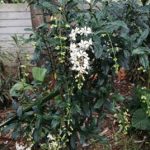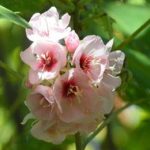TREE LIFE
June 2021
June 20th 2021: We are invited to Dereck and Anthea Brook Jackson who own a lodge on the banks of the Darwendale dam. It is about 70km so take lunch and share transport. Suggest meeting at 22 Bridgeway as we go out on the Lomagundi Road. Just after the toll turn left on to a tar road. Further instructions to follow.
July 18th 2021: To Margie Tredgold at Sublime. On a kopje overlooking Lake Chivero. Further instructions to follow.
CHAIRMAN’S REPORT 2020-2021 (71st AGM) HELD AT BRIDGEWAYS, AVONDALE, AT 10.00a.m. ON THE 9TH MAY 2021
I have pleasure in presenting my sixth annual Chairman’s report of the Tree Society of Zimbabwe covering the year 1 April 2020 to 31 March 2021. This report is for the 71st AGM meaning we should have done something special during the last year to commemorate the 70th year of the Tree Society of Zimbabwe but the Covid pandemic stopped that, Any ideas on what we should do? Let’s here from you. As you know the Covid-19 lockdown only eased off towards the end of last year for a short period before a second lockdown was imposed. We are only coming out of the second lockdown now and perhaps there will be more lockdowns before Covid-19 is finally conquered.
As a result, very few Tree Society outings took place in the last year. Some members were itching to go on a tree outing, so on Sunday 11th October 2020, Meg Coates Palgrave, Mark Hyde, Jan van Bel and myself met at the National Botanical Garden at 8:30 am for a trial tree outing. At the end of the outing, we agreed that we could resume our tree walks but to do them low key. To keep groups small, we only invited our members and did not advertise any of our outings to non-members. There then followed regular tree outings to the National Botanical Garden in November, December and January. We then had the second Covid 19 lockdown so no outing in February but we did resume tree outings in March when we went back to the National Botanical Garden on the first Saturday of the month and on the Sunday 28th March we went to 131 Enterprise Road, a property Ann Sinclair owns and wrote about in Tree Life 485. This property had many, many trees planted by Ann and is definitely worth another visit.
Tree Leaders: We are short of leaders and would really like a few more, any volunteers? You don’t have to know everything as whoever is participating can “chip in” and make the outings even more special!
Weekend Trips: Due to the lockdown no weekend trips took place.
Tree Life: Mary continues to be editor of Tree Life and although she has had some personal medical issues, she has managed to put out a very interesting series of Tree Lifes. With no outings to advertise and no reports of outings that took place, I commend Mary on being able to find sufficient material under very difficult times. Thank you Mary, what you have done is much appreciated.
Thanks to those who contributed write-ups on our outings and articles for Tree Life – in order of appearance: Mary Lovemore; Anna Lappé and Daniel Moss; Jim and Ann Sinclair; Tony Alegria; Ryan Truscott; Mary Toet; Ian Riddell; Meg Coates Palgrave; Paul Coates Palgrave; Kim Damstra (June 1990); Don Pinnock 23 June 2020; Clare Griffiths; Nell Lewis, CNN; Ann Sinclair; Werner Fibeck; Mark Hyde; Jan van Bel and Rob Paré (Nov 1992). Apologies to anyone I may have left out.
For the last year I feel that Ryan Trusscott with his interesting Tree of the Month articles has been the main contributor. Many thanks Ryan. We need more members to be able to put a Tree Life together so we can have more depth, you do not have to be a computer expert to do this. If you are interested, let me know.
Finances: The financial position of the Society remains satisfactory. The accounts and balance sheet were prepared by Bill Clarke. Bill looked at the society’s needs and set the annual subscriptions to what they are now – anyone paying later on will probably pay more as the subs. will be adjusted as needed depending on inflation.
Tree Society Facebook group: Since last year the group membership has increased by over 700 and now stands at over 4500.
Tree Society Website: During the last year, 1st April 2020 till 31st March 2021, there were 14,525 hits on the website. The top ten countries for the last year are listed and as expected the majority of hits came from Zimbabwe with 7793 followed by South Africa 1779; UK1365; USA1207; Australia 465; India 176; Canada 167; Zambia 89 and Germany 81.
During the year, besides getting all the Newsletters totally up to date, quite a few pages have been added to boost the website. Most of this material was supplied by Mary from past newsletters and other sources – once again, thanks Mary. We need to have two more members who can work on the Website – you do not have to be a computer Whizz Kid to do this. Let me know if you are interested.
Herbarium fumigation: Fumigation of the National Herbarium was carried out only once last year by Fumigation Services and we are overdue for the next fumigation exercise – the economic situation and Covid-19 can be blamed for this!
Tree Labeling: Not much work was done on this project in the last year mainly due to the pandemic but I am trying to increase the National Botanical Garden list from 300 to 325 trees. The additional 25 trees will fill the gaps in the present pamphlet with no need for extra pages. The new 325 pamphlet will be emailed to our members once finalized and should be available at the entrance gate for a fee. .
Christmas Party: Due to the Covid-19 pandemic, we did not have a Christmas Social in the last year. However, the last Xmas social held in December 2019 was poorly attended and the committee has agreed to have a social at some other time away from the rainy season when not much else is going on. So, we are having it today! I thank Ann Sinclair for booking this venue for our use.
Membership: As at the end of February 2020, we had 118 members, comprising ordinary, external and honorary members. This is an increase on last year’s numbers and this increase is due to the Tree Society of Zimbabwe website.
Committee: Since the last AGM, we have lost a committee member due to Jim Sinclair passing. The current committee consists of the following seven people: Ann Sinclair, Bill Clarke, Teig Howson, Ryan Truscott, Mary Lovemore, Jan van Bel and myself. In the last year we only met once – that was last month mainly to organize today’s events!
In conclusion … We have had a very interesting year!
Thank you.
-Tony Alegria
MINUTES OF THE 71st ANNUAL GENERAL MEETING OF THE TREE SOCIETY OF ZIMBABWE HELD ON 9th MAY 2017 AT BRIDGEWAYS AT 10.00 a.m.
PRESENT : T. Alegria (CHAIRMAN), J. van Bel, M. Lovemore, A. Sinclair, R. Truscott, W. Clarke (Hon. Treasurer), T. Howson(Secretary). Members : M. Coates Palgrave, G. Mills , D. Siemers , S. Worsley, F. Clarke, W. Fibeck, J. Dryburgh, Jen and Skip Mckay.
- NOTICE CONVENING THE MEETING
The notice convening the meeting had been sent out in the latest Tree Life, May 2021.
The Chairman welcomed everyone to the meeting and noted that there was a disappointing turnout. He requested members to observe one minute’s silence with respect to the late Jim Sinclair.
2. APOLOGIES: Apologies were received from the following members : M. Hyde, P. & F. Morris, P. Kingsland, M. Mason, S. Ingram, I. Riddell.
3. MINUTES OF THE 70th A.G.M.: had been circulated by e-mail and were taken as read. Acceptance of the minutes was proposed by Meg Coates Palgrave and seconded by Ann Sinclair.
4. MATTERS ARISING: The Chairman said that the previous AGM was the 70th and there should have been a special celebration for it. Werner suggested a Symposium for members only , numbers had to be limited because of COVID. Jan said a symposium would attract people from different groups like Parks, University, etc., but not necessarily Tree members. Tony thought a weekend away would be good, like the Vumba or Mutare.
Meg said that John Lawrence asked if Tree Society was still going on as he was not receiving any e-mails. Bill said John is on Mango and had paid his subs.
5. CHAIRMAN’S REPORT: The Chairman read his report for 2020-2021 which was his 6th Annual report which he had submitted for the next Tree Life. He thanked the committee for their input and thanked in particular Mary Lovemore and said that she was the most productive member on the Committee and requested her to remain on it. Mary agreed.
Tony said that more leaders were needed for outings and asked for volunteers. Jan said he would lead if necessary .
Tree Life was being very well done by Mary . Tony thanked Ryan for his “Tree of the month” articles and asked for more articles from members. Jan said he would submit more articles.
The financial situation was satisfactory and Bill would be presenting his report.
Facebook membership now numbered over 4500.
In the last year the Website had received 14,525 hits , mostly from Zimbabwe and S. He and Mary had added Tree Lifes and more pages but 2 more people were needed to be able to run it when necessary.
The Herbarium had only been fumigated once during the year so it had been overdue, but had been done last Friday. Chris Chapano was away in Norway but Tendai was in charge and reported that many dead insects had been found.
Tree Labelling was not being done due to the pandemic. Tony was extending the National Botanical Gardens list by another 25 trees to increase the numbers in the pamphlet, the new pamphlet would be sold at the entrance gate and circulated to members .
The 2019 annual Christmas party had been poorly attended and last year very few outings took place due to COVID.
Membership now stood at 118 which was an increase from last year.
6. FINANCIAL REPORT: Bill circulated copies of his annual Financial report and read through the figures and said that the situation was healthy. Subs would now be US$5 per annum. Mary proposed acceptance of the report and was seconded by Meg. Bill thanked them for acceptance and said the society could afford wine at the next Xmas party. Tony thanked Bill for all his work .
7. ELECTION OF OFFICERS: Isla Grundy had stepped down the previous year so there was need for two more committee members. There was no nomination for vice-Chairman and no volunteers to join the Committee.
Meg proposed that the present Committee be re-elected en bloc and was seconded by Graham Mills.
8. ANY OTHER BUSINESS: Meg congratulated the Chairman and Committee on their work during what has been a difficult year. Bill seconded this.
Werner commented that he preferred to concentrate on a particular genus on the walks. He said that there needs to be more publicity to attract new members.
Meg said in the past a tree would be allocated to a person who would then have to present all the facts at the outing. This encouraged people to take more part and ask questions and offer their own ideas.
Sue said that it is hard to attract new members but Mukuvisi as a popular venue could be used to publicise the Society and schools should also be made aware of the importance of trees. Prosper was growing seedlings at Mukuvisi and the Educational Department should utilise this.
There being no other business the meeting was declared closed at 11.18 a.m
Tree Society AGM / Social 9th May 2021
I was rather disappointed with the turnout for the event which ought to be the highlight of the year. If you only attend one event during the year, this should be the one! Present were: Ann Sinclair, Dawn Siemers, Meg Coates Palgrave, Mary Lovemore, Graham Mills, Jan van Bel, Ryan Truscott, Bill & Fiona Clarke, Skip & Jenny Mackay, Sue Worsley, Werner Fibeck, Teig Howson and myself.
Like every other Tree Society AGM I have been to, we started off by having tea and coffee with eats supplied by those attending. It was at this point I discovered that my buttered Ginger Bread slices were nowhere to be seen! I did find them later on but unfortunately only after I got home – that’s where they were! Thank you to all who brought eats.
The AGM followed and as per usual, we had no volunteers to go on the committee, so the old committee is now the new committee. The one thing that was pretty different was AOB. During this session, many ideas came up which the “NEW” committee will look at –ideas mostly to do with attracting and holding onto new members. Meg believes we are a social society and perhaps that’s what we need to portray, we are not a stuffy society with mostly professor type gurus!
Thereafter the scavenger hunt was on to find samples (bits and pieces) of thirty trees which Ann had selected. Two teams armed with enthusiasm and a plastic bag took off to locate these trees and place the evidence in the bags. Bill failed to find all the trees so he got samples of additional trees hoping to gain extra points by showing the “judge” his expertise – it didn’t work but nevertheless his team still won the event by 27 to 26 points. How the scoring system works: a member of a team presents a sample (leaf, leaves, pod or flower) from the plastic bag in no particular order to the Judge (Ann Sinclair) and tells her what he/she thinks the sample is, if Ann agrees, she locates the tree on the list and awards one point, if she is not sure she consults others and awards points – maximum 30 points.
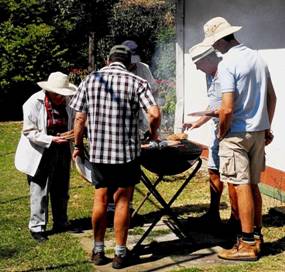
Social/AGM braai Photo by Jim Dryburg
Whilst the scavenger teams were doing their thing, a few less mobile members remained in the pavilion and had a chit chat whilst nibbling at the eats and having tea or coffee. I, in the meantime was pretty occupied with setting up the braai and making the sadza. I like having my lunch at lunch time which I consider to be one o’clock and thus had the fire ready to braai as soon as the scavenger hunt was over – and there was sufficient time to braai and eat at one o’clock.
At about 13:50 hours, we decided to have the fun quiz, three teams participated and the first thing they had to do was give themselves a team name. After every 25 questions were asked, papers were swapped and marked with running totals, altogether 100 questions were asked with the teams scoring about 80%. Thereafter prize giving for the winning team followed, but it didn’t stop there, the second and third team were also awarded prizes – and it wasn’t the traditional Gold, Silver and Bronze – everyone ended up with a bar of chocolate. Thanks Bill for another FUN QUIZ.
Socialising resumed after the quiz with more tea and coffee being consumed than the alcoholic drinks – sign of the times? It was a most enjoyable day, those who didn’t come along missed out on a fun day.
-Tony Alegria
Sunday 18th April 2021 Tree Society Outing to Jan Teede’s Garden , at 8 Princes Close Harare
A small gathering of Tree Society members came for a fascinating morning
Mark, Tony, Dawn, Meg, Karl, Marylin and Ann. We were met by Tore Ballance and Alistair Hull who have been involved in the creation of this wild indigenous garden. Sadly Jan Teede was away but there is so much of interest we hope to be able to return for another visit.
Tore started with a brief history of the garden. Jan inherited the garden from his father in law a few years ago. The garden was flat with plenty of exotics large old Jacarandas and Tipuana tipu. The plan was to create a landscape away from the exotics and the flat ground. Tons of rocks were brought in from Dombashava and to begin with they planted Highveld species, and reduced the canopy to medium sized trees and shrubs. They created a meadow effect with grasses, these grow wild but require management. Aloes have been used to good effect among the rocks. The rocks keep in the heat of the sun.
The number of bird species that now inhabit the garden is amazing. The grasses and weeds and flowering shrubs attract numerous butterflies.
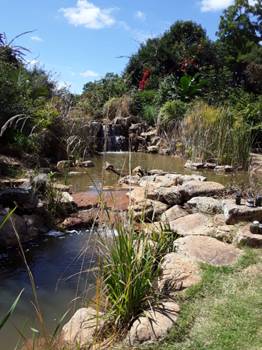
Backyard water feature Photo by Tony Alegria
The garden is landscaped to connect to the house and it flows into the courtyard with a mix of grasses, succulents, creepers and shrubs. At the side of the house, behind a wall is a vegetable garden with plants falling over the wall including herbs and a Bauhinia galpinii. Along the side of the house, they have created a magnificent water feature. A waterfall tumbles into a pool which also serves as a swimming pool with a sandy bottom. This flows out in a stream to join the reservoir. Six species of bream live in the pool and it is clothed with small trees and shrubs.
Water is collected from the roof and led into a drain line which feeds into the reservoir.
After landscaping they added the plants. Sixty to seventy species of indigenous trees and shrubs have been planted so far. The plants were sourced from Emerald Seedlings Nursery, The Williams in Turk Mine and Bushy Landscapes in Bluff Hill.
To mention a few of the many species in the garden:
- a very healthy Trema orientalis, the Pidgeonwood, which grows in a number of habitats, but prefers moist soils.
- Tabernaemontana spp,
- Philenoptera spp, was in flower,
- Cussonia spicata,
- Androstachys johnsonii (which is good to plant in pure sand). This is a lowveld tree occurring in the South of Zimbabwe.
- Acalypha have been planted to attract butterflies.
- Mondia whitei, a creeper from the Eastern Districts,
- Hypericum revolutum, the curry bush,
- Grewia occidentalis and
- Grewia pachycalyx with white flowers
- Snowberry, Flueggea virosa, and
- Carissa macrocarpa with white flowers and edible fruits.
We enjoyed our morning’s visit to this fascinating garden.
Thank you to Jan and Tore.
-Ann Sinclair
Charaxes and Confetti trees
I suppose the Confetti tree holds a special place in my heart because the first time I saw one was on my very first Tree Society outing.
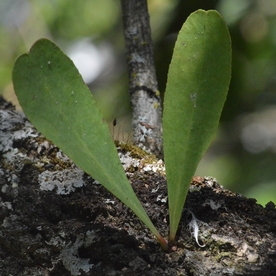
The leaves are distinctly obovate Photo by Ryan Truscott
It was in the Mukuvisi Woodlands on an unseasonably cold, overcast Saturday afternoon in late 2017.
Once seen, the Confetti tree, Gymnosporia senegalensis cannot be forgotten.
It’s a small tree or shrub with distinctively obovate leaves. Their shape reminds me of the ears of a scrub hare, especially when they emerge in pairs.
Another key feature is the colour of the shoots, which are as red as my bush dog’s pelt. It is this feature that probably inspires the tree’s common name in South Africa: the Red spike-thorn.
But it is the flowers that give the tree our Zimbabwean English name. Small, white and delicate, they fall like confetti when the branches are shaken.
May is the month the tree comes into flower so it is fitting that it should be our tree of the month.
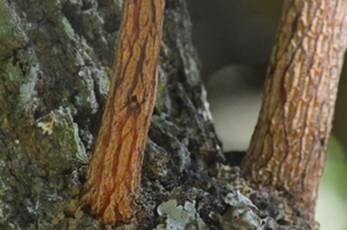
Red branchlets are a key feature Photo by Ryan Truscott
It’s not uniquely Zimbabwean. This is a cosmopolitan tree, occurring in Africa, Asia and Europe.
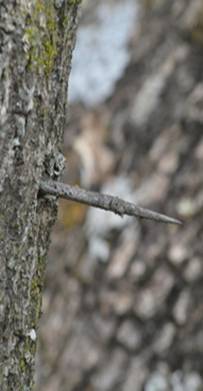
The confetti tree is armed with thorns
Photo by Ryan Truscott
The confetti tree is armed with thorns
Its persistence is not assured everywhere though.
In Spain, where it is considered part of a relict ecosystem, G. senegalensis faces extinction due to intensive agricultural practices, climate change and habitat fragmentation, scientists wrote in a 2020 study.
The Confetti tree is hugely significant as a medicinal plant.
My Common Trees of the Highveld cites some of its uses: the bark for treating head lice in India; the roots to treat haemoptysis in South Africa; an infusion of the leaves for snakebites in Zambia.
Some recent studies have shown extracts of the plant to be effective against drug-resistant strains of TB.
I’m glad to have this tree growing in our garden.
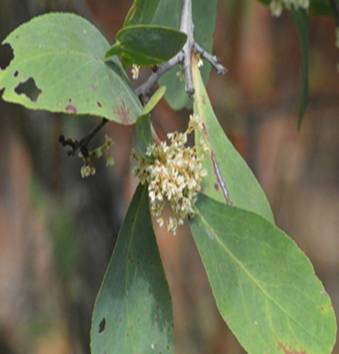
Flowers occur in dense clusters Photo by Ryan Truscott
It has been depositing its tiny white flowers on the ground where it grows next to an African wattle, Peltophorum africanum. In the summer its leaves will provide forage for caterpillars, including various species of butterfly.
I took delight in telling my daughter this when she brought home an injured butterfly in March. It was a cherished gift from her friend Scott, a keen young lepidopterist.
The butterfly’s damaged wings were closed upright, exposing only the underwings and their intricate pattern of reddish brown, black, white and grey. We initially took it for a Foxy charaxes whose caterpillars are known to feed on the leaves of the Confetti tree.
My daughter named her injured charge Skyfall, fed it on sugared water in a China saucer and, with the insect perched on her forefinger, took it for walks around the garden.
It was only once Skyfall had opened her quivering wings in the sun that we saw the bold white band struck across the dark upper wings and could identify her correctly as a White-barred charaxes.
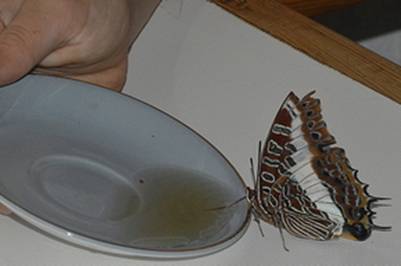
Feeding Skyfall on homemade nectar Photo by Ryan Truscott
Their caterpillars feed on the leaves of the Forest Natal mahogany, Trichelia dregeana. We don’t have any in our garden though they are plentiful in the neighbourhood. This month they’ve been full of clusters of light green fruit.
The Confetti tree is the larval food plant of two other charaxes species: the Emperor charaxes and the Blue-spotted charaxes, which occur in eastern Zimbabwe. But its leaves also feed the caterpillars of the Purple brown hairstreak, a common and widespread butterfly that we’ll be sure to look out for in our garden over the coming weeks.
-Ryan Truscott
TREE SOCIETY OUTING SUNDAY 16TH MAY 2021
25 Trafalgar Avenue, Sentosa is an amazing and very interesting property on a rocky kopje. One could imagine being right out in the country instead of in a Harare suburb. For the past seven years it has been the home of Zia Thomas and Bruce Cowley and they warmly welcomed the seven Tree Society members who gathered there on the glorious winter’s morning of Sunday 16th May 2021. Members present were Tony, Ann, Meg, Mark, Jan, Jim and Dawn.
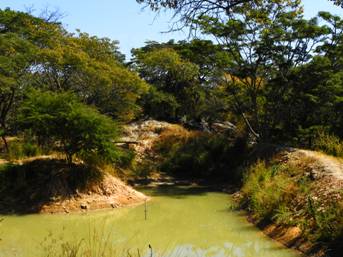
The dam. Photo by Jim Dryburg
We started off by looking at a couple of creepers – Solanum seaforthianum (the Brazilian nightshade) and related to the potato family and, on the same Grewia monticola tree, a wild cucumber with its fruit covered in prickles. Nearby was a very small Senna singueana with its little ‘beestings’ in the leaf axles.
At this time of the year, many of the trees are leafless, making identification more difficult for most people but not so for our ‘Gurus’! They identified a Steculia quinqualoba by its peeling bark and three large dead leaves and a Lannea discolour by its ‘fat fingers’. We felt
the leaves of the Snot Apple – rough on the upper surface and soft underneath. Because of the dire shortage of water, Zia and Bruce had decided to build a dam where there had been a tennis court and on our way to the dam we passed a Rhus tenuinervis which was full of fruit and a very small Tamarindus indica.
Mark took us to see ‘his weed’ growing beside the dam. This plant, Acmella radicans, a member of the sunflower family, is thought to have come originally from Central America. It became established in Zambia some years ago and is now widespread in Zimbabwe.
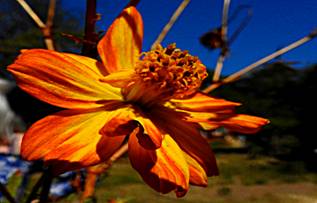
Bidens asteraceae Photo by Jim Dryburg
Curiously, its tiny flower parts are tucked away inside what looks like a little bud. Another plant which has established itself here and grows on the roadsides together with the Cosmos and Mexican Daisies, is the Bidens asteraceae which is a perennial with pretty golden blooms when in flower. It is very prolific and covered a large patch of the garden.
Besides the two friendly dogs who enjoyed walking with us, we were joined by hens and guinea fowl. The more vicious geese, who particularly did not like males, were in a separate enclosure. There were also several tortoises hiding on the property. In the area of the wildlife was a magnificent specimen of a Confetti tree in full bloom with many busy bees and some flies among the blossoms. The flowers seemed to have a greenish tinge instead of the pure white normally seen.
We passed a Giant Timber Bamboo with its very large leaves. These plants were imported as a commercial venture which didn’t take off. Two other curiosities were the Kalahari Melon creeper planted as a ground cover and which had produced a giant melon about 18” across and a ceramic toilet complete with seat and lid standing way out in the open!
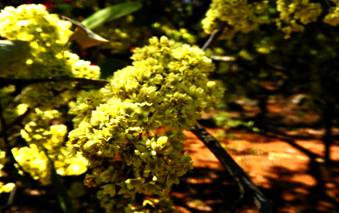 A very large crown gall on what looked like a dead Msasa tree prompted a most interesting impromptu talk by Bruce on genetic modification in plants. Apparently transferring a gall from one plant to another also transfers the host plant’s genetic make-up.
A very large crown gall on what looked like a dead Msasa tree prompted a most interesting impromptu talk by Bruce on genetic modification in plants. Apparently transferring a gall from one plant to another also transfers the host plant’s genetic make-up.
All in all it was a very pleasant and interesting morning and we extend our thanks to Zia and Bruce for their hospitality.
-Dawn Siemers
Chairman – Tony Alegria
The Tree Society’s e-mail address is via the website.


